How to Fertilize Blueberries for Explosive Growth: Unlock Maximum Yields
- April 8, 2024
- 0 comment
Discover the secrets on how to fertilize blueberries for guaranteed peak yields. Learn expert tips to boost your harvest in this essential guide. Growing blueberries can be very rewarding if you get the fertilization part right. This guide is packed with simple, effective tips that promise to help you boost your blueberry yield. We’ll walk you through each step, making sure you know exactly what to do and when to do it, to ensure your blueberry plants are healthy and productive.
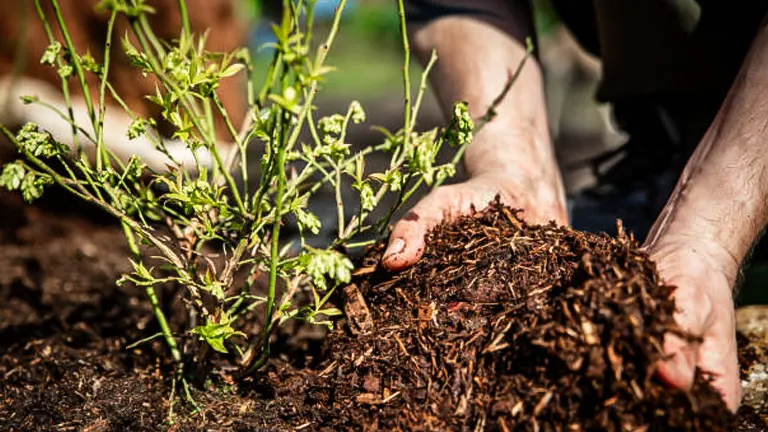
Whether you’ve been gardening for years or are just starting out with your first blueberry bush, these guidelines are designed to help everyone achieve a bigger, better harvest. From choosing the right fertilizer to understanding the best times for application, we’ve got you covered. Let’s get started on the path to enjoying more delicious blueberries right from your backyard.
Table of Contents
- Understanding Blueberry Nutrition Needs
- The Right Time to Fertilize
- Choosing the Right Fertilizer
- Step-by-Step Guide on How to Fertilize Blueberries
- Common Fertilizing Mistakes to Avoid
- Planting Blueberries: Spacing for Success
- Pruning Techniques for Blueberry Plants
- Advanced Tips for Bigger Yields
- Troubleshooting Poor Fertilization Outcomes
- Conclusion
- FAQs
Understanding Blueberry Nutrition Needs
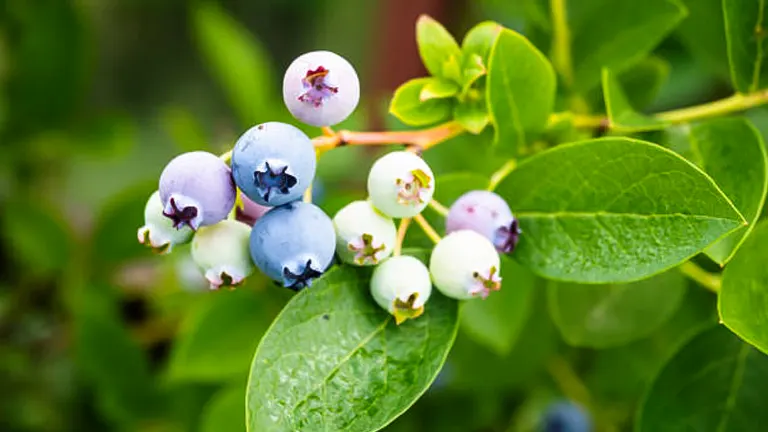
Blueberries, with their distinctive flavor and nutritional profile, demand specific soil and nutrient conditions to flourish. Unlike many other garden plants, blueberries thrive in highly acidic soil, with an optimal pH range of 4.5 to 5.5. This acidity level enhances the plant’s ability to absorb essential nutrients effectively, crucial for their growth and fruit production.
Key Nutrients and Their Roles
The nutritional regimen for blueberries centers around three primary nutrients: nitrogen (N), phosphorus (P), and potassium (K) — collectively known as NPK — each serving a vital role in the plant’s lifecycle:
- Nitrogen (N): Vital for vegetative growth, nitrogen promotes healthy leaf and stem development, directly influencing the plant’s ability to photosynthesize and, consequently, its fruit yield.
- Phosphorus (P): Essential for root development and the maturation of fruit, phosphorus supports the transfer of energy throughout the plant, aiding in the formation of flowers and ensuring berry quality.
- Potassium (K): Potassium regulates physiological processes, including water uptake and enzyme activation, crucial for disease resistance and fruit development.
In addition to these macronutrients, blueberries require a suite of micronutrients — magnesium (Mg), sulfur (S), and calcium (Ca) — each contributing uniquely to the plant’s health and productivity:
- Magnesium (Mg): A core component of chlorophyll, magnesium is key for photosynthesis and sugar synthesis, impacting berry sweetness and plant vigor.
- Sulfur (S): Integral for protein synthesis, sulfur also plays a role in disease resistance and growth regulation.
- Calcium (Ca): Important for cellular development and growth, calcium contributes to the structural integrity of cell walls, enhancing the plant’s overall strength and stability.
Nutrient Requirements Table
To better illustrate the blueberry plant’s nutritional needs, here’s a scientific breakdown:
| Nutrient | Function | Recommended Concentration (ppm)* |
|---|---|---|
| N | Leaf and stem growth, photosynthesis | 50-150 |
| P | Root development, flower and fruit maturation | 30-50 |
| K | Water regulation, disease resistance | 50-250 |
| Mg | Chlorophyll production, photosynthesis | 20-30 |
| S | Protein synthesis, disease resistance | 15-30 |
| Ca | Cell wall structural integrity, growth | 25-50 |
*ppm: parts per million
Advanced Insights
For those with a keen interest in optimizing blueberry production, consider the role of micronutrient balance and soil pH in unlocking the full potential of your blueberry bushes. Techniques such as soil amendment with elemental sulfur to lower pH or the application of chelated forms of micronutrients can significantly impact nutrient availability and absorption. Monitoring soil conditions and conducting regular leaf tissue analysis can provide precise data, enabling targeted nutritional interventions for peak berry production.
The Right Time to Fertilize
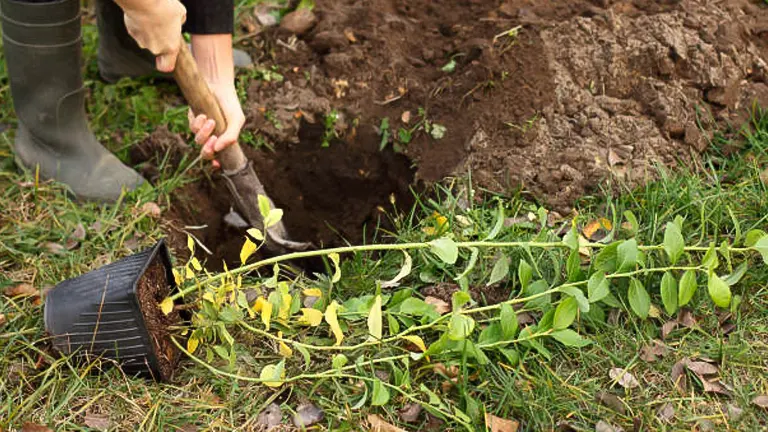
Timing the fertilization of blueberries is not just about the calendar; it’s about understanding the plant’s growth cycle and physiological needs at each stage. The objective is to synchronize the application of nutrients with key developmental phases of the blueberry plant, maximizing efficiency and supporting optimal growth and fruit production.
Key Fertilization Phases
- Early Spring (Bud Break): This initial phase is critical as the plants exit dormancy and begin new growth. Applying a balanced fertilizer at this stage provides the necessary nutrients for leaf growth and root development, setting the foundation for the season’s growth.
- Late Spring to Early Summer (Pre-Berry Set): As the plants transition from flowering to fruit set, a second fertilization supports this energy-intensive phase. This application boosts fruit development and fortifies the plants against the upcoming summer stressors.
- Post-Harvest (Optional): For regions with longer growing seasons, a light post-harvest application can promote root development and prepare the bushes for winter, though this must be done with caution to avoid late-season growth that can be damaged by frost.
Avoiding Late-Season Fertilization
Late-season fertilization, particularly past mid-summer, is generally discouraged. New growth prompted by late fertilization is less likely to harden off properly before winter, increasing susceptibility to cold damage. Additionally, it can divert the plant’s energy from fruit development and storage reserves for winter survival.
Fertilization Timing Table
To provide a more scientific perspective, below is a table outlining the optimal fertilization timings and the focus of each application:
| Timing | Objective | N-P-K Ratio | Notes |
|---|---|---|---|
| Early Spring (Bud Break) | Support leaf growth and root development | 12-4-8 or similar | Begin when new growth appears |
| Late Spring (Pre-Berry Set) | Boost fruit development, plant strength | 10-10-10 or similar | Apply before berries form, adjust for soil test results |
| Post-Harvest (Optional) | Encourage root growth, prepare for dormancy | Lower N, higher P-K | Only in regions with extended growing seasons |
Advanced Considerations
For those seeking to optimize their blueberry fertilization regimen further, consider incorporating soil and tissue testing into your annual management practices. Soil tests can reveal specific nutrient deficiencies and pH imbalances, while tissue tests offer insights into the plant’s actual nutrient uptake. These tests allow for precise adjustments to fertilization strategies, ensuring that plants receive exactly what they need, when they need it.
Additionally, understanding the role of environmental factors such as temperature, rainfall, and soil moisture can help refine fertilization timing. For instance, in years with heavy spring rains, additional nitrogen may be necessary to compensate for leaching losses.
By adopting a strategic approach to fertilization, grounded in the physiological needs of the blueberry bush and the specific conditions of the growing season, gardeners and producers can significantly impact the health of their plants and the quality and quantity of their fruit yield.
Choosing the Right Fertilizer

The selection of an appropriate fertilizer is crucial in cultivating thriving blueberry plants. Due to blueberries’ specific soil pH requirements and nutrient needs, the choice between organic and synthetic fertilizers, and understanding their respective benefits and compositions, becomes paramount.
Nutrient Composition and Requirements
Blueberries flourish in acidic soil, with an ideal pH range of 4.5 to 5.5, necessitating fertilizers that not only provide essential nutrients but also support or maintain this acidity. The primary nutrients required by blueberries are nitrogen (N), phosphorus (P), and potassium (K), with an emphasis on formulations that encourage strong vegetative growth and fruitful harvests.
- NPK Ratios: Ideal formulations for blueberries might include ratios such as 12-4-8 or 10-5-4, indicating the percentages of nitrogen, phosphorus, and potassium, respectively. These ratios are designed to support overall health, root development, and berry production.
Organic vs. Synthetic Fertilizers: A Comparative Analysis
| Fertilizer Type | Characteristics | NPK Ratio Examples | Benefits | Considerations |
|---|---|---|---|---|
| Organic | Derived from natural materials; slow-release of nutrients; improves soil health | Varied | Enhances microbial activity in soil, gradual nutrient release, reduces leaching | Nutrient levels can be less predictable; may require more frequent application |
| Synthetic | Man-made chemicals; quick nutrient release | 12-4-8, 10-5-4 | Precise nutrient composition; immediate availability of nutrients | Can lead to nutrient runoff; potential for overfeeding and plant damage |
Organic Options
Organic fertilizers, such as well-composted pine bark or cottonseed meal, are favored for their slow-release nitrogen and their contribution to maintaining acidic soil conditions. These options not only nourish the plants but also enhance soil structure and health, promoting a vibrant microbial ecosystem crucial for nutrient absorption.
- Micronutrient Consideration: When opting for organic fertilizers, supplementing with specific micronutrients (e.g., iron, magnesium, sulfur) may be necessary to address blueberries’ extensive needs.
Synthetic Fertilizers
Synthetic fertilizers offer a concentrated and immediate source of nutrients, essential for quick corrections or boosts in plant health. Formulations specifically designed for acid-loving plants can help maintain the desired soil acidity while providing a balanced nutrient supply.
- Slow-Release Formulas: To mitigate the risks of nutrient overload and leaching, selecting synthetic fertilizers with slow-release properties ensures a steady nutrient supply without overwhelming the plants.
Importance of Micronutrients
Blueberries’ demand for micronutrients like iron (Fe), magnesium (Mg), and sulfur (S) is notable. These elements play critical roles in chlorophyll production, enzyme function, and overall plant health, underscoring the need for a holistic approach to fertilization that includes both macro and micronutrients.
- Product Selection: Whether opting for organic or synthetic, choose fertilizers that include or are supplemented with essential micronutrients to ensure balanced nutrition.
Advanced Considerations
For gardeners and cultivators seeking to optimize their blueberry yields through precise nutrient management, conducting soil tests can provide invaluable insights into existing nutrient levels and pH. Tailoring fertilizer choices based on these data can significantly enhance plant health and fruit production, ensuring that every application addresses the specific needs of the blueberry bushes.
Step-by-Step Guide on How to Fertilize Blueberries
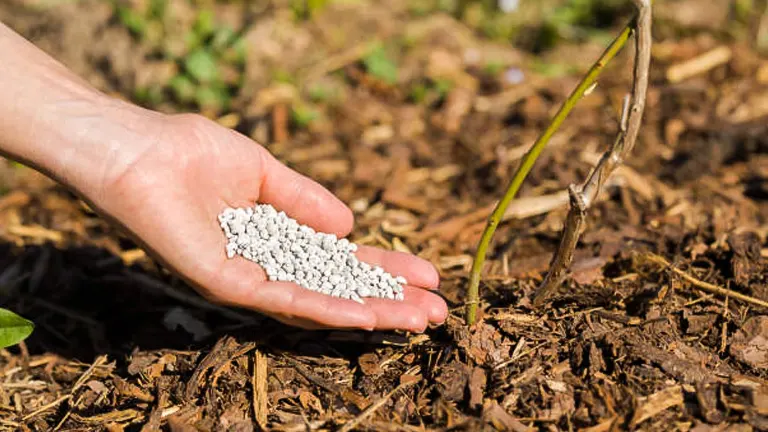
Fertilizing blueberries is a critical aspect of their care, requiring precision in both the selection and application of fertilizer. Achieving maximum yield and health from your blueberry bushes involves more than just choosing the right fertilizer; it’s about applying it in a way that aligns with the plant’s specific needs at different growth stages.
Step 1: Choose the Right Fertilizer
- Select a fertilizer that is suited for acid-loving plants with an NPK ratio appropriate for blueberries, such as 12-4-8 or 10-5-4.
- Consider the type: Decide between organic and synthetic based on your gardening preferences. Organic fertilizers improve soil health over time, while synthetic fertilizers offer quick nutrient release.
Step 2: Soil Testing (Optional but Recommended)
- Conduct a soil test to determine the current nutrient levels and pH. This helps tailor the fertilizer type and amount to your plants’ specific needs.
- Adjust pH if necessary, aiming for a range of 4.5 to 5.5, using sulfur to lower pH or lime to raise it, based on the test results.
Step 3: Timing Your Application
- Apply the first round of fertilizer in early spring as new growth appears (bud break).
- Follow up with a second application in late spring to early summer, just before the berry set, to support fruit development.
Step 4: Preparing the Fertilizer
- For granular fertilizers: Measure the recommended amount based on the product instructions and the size/age of your plants.
- For liquid fertilizers: Dilute the fertilizer according to the package directions.
Step 5: Applying the Fertilizer
- Granular Application:
- Scatter the granules evenly around the base of the plant, starting a few inches away from the stem and extending to the drip line.
- Use a rake to lightly mix the fertilizer into the top layer of soil.
- Liquid Application:
- Pour the diluted solution evenly around the root zone of each plant.
- Avoid applying directly on the leaves or stems.
Step 6: Watering In
- Thoroughly water the area around each plant after applying fertilizer. This helps move the nutrients into the soil where they’re accessible to the roots and prevents fertilizer burn.
Step 7: Monitoring and Adjusting
- Observe your plants for signs of over-fertilization (such as leaf burn or stunted growth) and adjust future applications as necessary.
- Repeat soil tests annually to refine your fertilization strategy.
Additional Tips:
- Integrate organic matter: Incorporate compost or aged manure into the soil annually to enhance soil structure and provide a slow-release nutrient source.
- Keep records: Note the types and amounts of fertilizer used and your plants’ responses over time to tailor your approach to your specific conditions.
Common Fertilizing Mistakes to Avoid
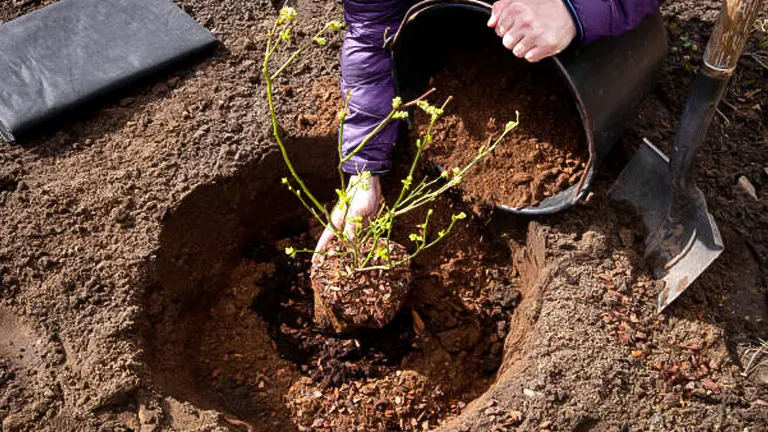
To ensure your blueberry bushes thrive and produce bountiful yields, it’s just as important to know what not to do as it is to follow best practices. Avoiding these common fertilizing mistakes can prevent potential issues that could hinder your blueberry plants’ health and productivity:
Over-fertilizing: The Risk of Excess
- Consequences of Over-application: Applying too much fertilizer can cause more harm than good. Excessive amounts lead to a salt buildup in the soil, which can dehydrate and damage the plant’s roots, impairing their ability to absorb water and nutrients. This stress can manifest as burned leaf margins, stunted growth, and a noticeable decline in berry production.
- Preventative Measures: Use a soil test to determine nutrient needs before applying fertilizer. Follow recommended rates closely, and consider the plant’s age and size. It’s better to under-fertilize and adjust as needed than to overdo it from the start.
Wrong Timing: Understanding Growth Cycles
- Impact of Late Season Fertilization: Fertilizing too late in the season can stimulate new growth that doesn’t have sufficient time to harden off before winter, leaving the plant vulnerable to frost damage and weakening its overall hardiness.
- Ideal Timing: The last fertilizer application should be no later than mid-summer to ensure all new growth has time to mature and harden before the cooler temperatures of fall and winter.
Ignoring Soil pH: The Foundation of Nutrition
- The Importance of Soil Acidity: Blueberries require acidic soil conditions (pH 4.5 to 5.5) to thrive and absorb nutrients efficiently. Applying fertilizer without considering the soil’s pH can render even the most well-balanced nutrients ineffective, as certain minerals become unavailable to the plant at incorrect pH levels.
- Adjusting Soil pH: Regularly test soil pH and adjust as necessary using sulfur to lower the pH or lime to raise it. This ensures that your fertilization efforts are not in vain and that your blueberry plants can access the nutrients they need.
Additional Considerations to Enhance Fertilization Success
- Uniform Application: Ensure that fertilizers are applied evenly around the plant, extending out to the drip line, to avoid concentrated areas of nutrients that could harm the root system.
- Understanding Nutrient Mobility: Some nutrients, like nitrogen, are highly mobile in the soil and can be leached away by rainfall, whereas others, such as phosphorus, are more stable. Consider these characteristics when choosing fertilizers and determining application rates.
- Organic Matter: Incorporating organic matter into the soil can improve its structure, water retention, and microbial activity, all of which enhance the effectiveness of your fertilization regimen by making nutrients more accessible to the plants.
Planting Blueberries: Spacing for Success
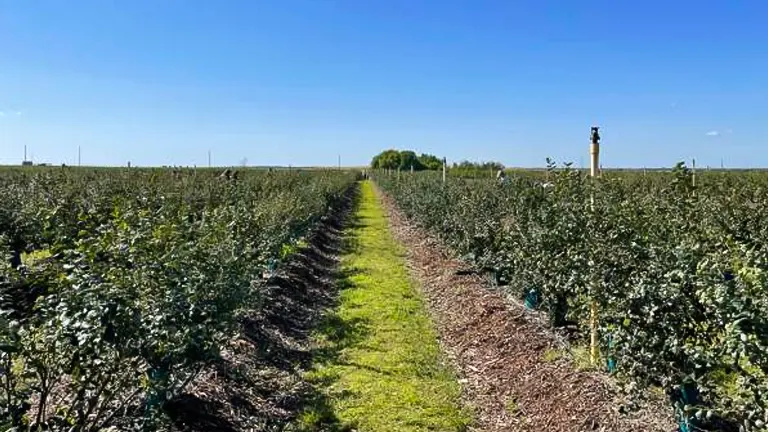
When establishing a blueberry orchard, whether for personal enjoyment or commercial production, understanding and implementing correct spacing is key to your success. The spacing between plants directly influences their access to sunlight, air circulation, and nutrients, all of which are crucial for healthy growth and abundant fruit production.
- Medium-Density Orchards: For those planting blueberries at a medium density, aim for spacing your plants about 4 to 5 feet apart. This allows each blueberry bush enough room to grow and spread without competing too heavily with its neighbors for resources. Rows should be spaced 9 to 10 feet apart to facilitate easy access for maintenance, harvesting, and to ensure each plant receives ample sunlight.
- High-Density Planting: In high-density settings, common in commercial operations where space might be at a premium, plants can be placed closer together, typically 3 feet apart. Row spacing in such cases is often reduced to 8 to 9 feet. While this approach maximizes the number of plants per acre, it also necessitates diligent management of irrigation, fertilization, and pruning to prevent over-crowding and to maintain plant health.
Properly spacing your blueberry plants not only optimizes their growth environment but also makes tasks like pruning, pest management, and harvesting more manageable. It’s a foundational step that sets the stage for your blueberry bushes’ health, productivity, and longevity.
Pruning Techniques for Blueberry Plants
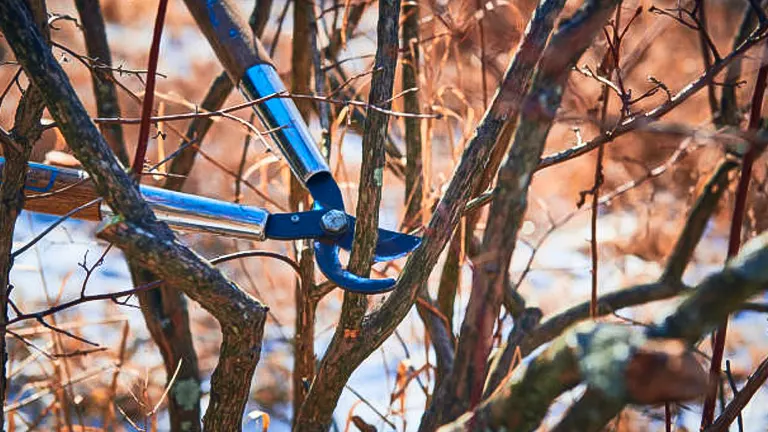
Pruning is an essential practice in the care of blueberry bushes, vital for stimulating growth, ensuring plant health, and maximizing fruit production. It might seem counterintuitive, but selectively cutting back parts of the plant actually encourages more vigorous growth and larger, more plentiful berries.
- When to Prune: The best time to prune blueberry bushes is late winter to early spring before new growth starts. This timing allows you to easily see the structure of the plant and make clean cuts that the plant can heal quickly from as it enters its growing season.
- How to Prune: Start by removing any dead or diseased wood, which can drain energy from the plant and potentially spread disease. Next, thin out the center of the bush to increase air circulation and light penetration. Remove any small, weak branches that are unlikely to produce fruit. Focus on creating an open, vase-like shape to the bush.
- Older Stems: Identify and remove up to one-third of the oldest stems annually. These are typically the thickest, most rigid branches with peeling bark. Removing these encourages the growth of younger, more productive stems that will bear the bulk of the fruit.
- Renewal Pruning: For older or neglected bushes, more drastic “renewal” pruning may be necessary. This involves cutting all the stems down to about 6-12 inches from the ground to rejuvenate the plant. While this will reduce or eliminate fruit production in the first year after pruning, it can revitalize the bush for more vigorous growth and better yields in subsequent years.
Pruning might seem like a daunting task, but it’s a straightforward practice that can have a profound impact on the health and productivity of your blueberry bushes. By following these guidelines, you ensure your blueberry plants have the best conditions for growth, leading to delicious and abundant harvests.
Advanced Tips for Bigger Yields
To push your blueberry bushes towards their peak productivity, consider these additional practices:
- Soil pH Management: Blueberries thrive in acidic soil. Regularly test your soil’s pH and, if necessary, use sulfur or iron sulfate to lower it to the optimal range (4.5 to 5.5). Achieving the right pH ensures your plants can absorb the maximum amount of nutrients from the soil.
- Mulching: Apply a thick layer of organic mulch, such as pine needles or shredded leaves, around your blueberry bushes. Mulch helps retain soil moisture, keeps roots cool, and gradually breaks down to add nutrients back into the soil. It also helps maintain an acidic soil environment.
- Consistent Watering: While not directly related to fertilization, consistent watering is crucial, especially during berry formation and ripening. Blueberries have shallow root systems and can dry out quickly. Use a drip irrigation system or soaker hoses to keep the soil moist but not waterlogged.
- Pruning: Regular pruning of older branches encourages new growth and can lead to larger berries. Prune bushes in late winter, removing any dead or weak branches and opening up the center of the plant to allow light and air circulation.
Troubleshooting Poor Fertilization Outcomes
Even with the best care, you might encounter some issues. Here are tips for diagnosing and correcting common fertilization problems:
- Yellowing Leaves (Chlorosis): This often indicates an iron deficiency, common in blueberries when the soil pH is too high. Adjusting the soil pH back into the acidic range can help, as can applying a chelated iron supplement.
- Poor Growth or Small Berries: If your plants are not growing as expected or the berries are small, it could be a sign of nitrogen deficiency. Consider adjusting your fertilization strategy to include a higher nitrogen content.
- Leaf Burn: If you notice the edges of leaves turning brown or crispy, it might be due to over-fertilization. Flush the soil around your plants with water to help dilute excess fertilizer and avoid applying more until growth resumes normally.
Related Post
- How to Fertilize a Mango Tree Effectively: Tips and Tricks for Healthy Growth
- How to Fertilize Apple Trees: Essential Tips for a Bountiful Harvest
- How to Fertilize Lemon Trees: Secrets for Thriving Citrus
- How to Fertilize Avocado Tree: A Step-by-Step Guide for Lush Growth
Conclusion
Fertilizing blueberries doesn’t have to be complicated. With the right preparation, timing, and care, you can enjoy bountiful harvests of juicy, sweet berries from your garden. Remember to choose a suitable fertilizer, apply it at the correct times, and adjust your care based on the plant’s performance and soil conditions. By following these guidelines, you’re well on your way to achieving guaranteed peak yields and making the most of your blueberry bushes.
FAQs
- What’s the best time of year to start fertilizing blueberries?
Begin fertilizing your blueberries in early spring as new growth appears. A second application should be done in late spring or early summer, just before the berries start to form. - Can I use the same fertilizer for my blueberries that I use for other plants?
Blueberries require a specific type of fertilizer due to their preference for acidic soil. Look for fertilizers labeled for acid-loving plants, which have the right balance of nutrients for blueberries. - How often should I fertilize my blueberry plants?
Generally, fertilizing twice a year is sufficient — once in early spring and again in late spring or early summer. Avoid fertilizing late in the season to prevent new growth that could be damaged by frost. - What should I do if my blueberry leaves start turning yellow?
Yellow leaves could indicate an iron deficiency, common in blueberries when the soil isn’t acidic enough. Consider using a soil acidifier or iron supplement to adjust the pH level. - How much fertilizer should I use for each plant?
Follow the manufacturer’s recommendations on the fertilizer package, adjusting for the size and age of your blueberry plants. Over-fertilizing can harm your plants, so it’s crucial to measure accurately. - Is organic fertilizer better for blueberries than synthetic?
Both can be effective, but organic fertilizers improve soil health over time and release nutrients slowly. If you prefer quick results and precise nutrient management, synthetic fertilizers might be the way to go. - Can I use coffee grounds as a fertilizer for my blueberries?
While coffee grounds can help acidify the soil, they should not be relied on as the sole source of nutrients. They’re best used as a soil amendment in conjunction with a balanced fertilizer. - How do I know if I’m over-fertilizing my blueberry bushes?
Signs of over-fertilization include burnt-looking edges on leaves, stunted growth, and poor berry production. If you notice these signs, reduce the amount of fertilizer and water your plants deeply to help flush out excess nutrients.
This guide aimed to provide you with essential steps for optimally fertilizing your blueberries, setting the stage for explosive growth and maximum yields. Armed with these insights, you’re now ready to elevate your blueberry cultivation to new heights. Here’s to a garden brimming with healthy, bountiful blueberry bushes!

Benjamin Brooks
Forestry AuthorGreetings! I'm Benjamin Brooks, and my journey over the past 15 years has revolved around the fascinating realms of content creation, expertise in snow clearing, and the intricate world of lumberjacking and landscaping. What began as a simple curiosity about the natural world and heavy machinery has evolved into a passionate profession where my love for crafting words intertwines seamlessly with my lumberjacking and garden skills.













Leave your comment